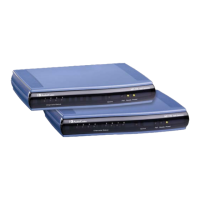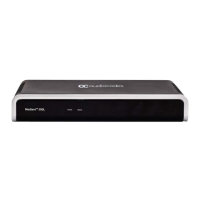Version 5.2/5.4 51 January 2009
Troubleshooting Guide 8. Fax and Modem
8 Fax and Modem
This section discusses troubleshooting for fax and modem calls.
8.1 Why Do Fax Sessions Fail
Each fax session begins with a regular voice call setup process. Only after this voice
channel has been successfully established does fax negotiation begin.
Table 8-1: Fax Failure Troubleshooting
Possible Cause Solution
1.
Voice call setup prior to fax
negotiation failed.
Verify normal SIP/VoIP call setup establishment (refer to
''Call Setup'' on page 19).
2.
Incorrect Fax transport type. Ensure that the fax transport type configured for the device
is the same fax transport type supported by the remote
gateway or UA. The supported fax transport methods to
send fax over IP include the following:
T.38 fax relay - fax signals are sent using the T.38
protocol. Relevant parameters include the following:
9 IsFaxUsed (= 1 for switching to T.38 mode using SIP
Re-INVITE; = 0 for automatically switching to T.38
mode without SIP Re-INVITE)
9 FaxTransportMode = 1 (only for automatically
switching to T.38 mode without SIP Re-INVITE)
9 FaxRelayEnhancedRedundancyDepth
9 FaxRelayRedundancyDepth
9 FaxRelayECMEnable
9 FaxRelayMaxRate
Fax bypass - a proprietary method that uses a high bit-
rate coder. Relevant parameters include the following:
9 IsFaxUsed = 0
9 FaxTransportMode = 2
9 V21ModemTransportType = 2
9 V22ModemTransportType = 2
9 V23ModemTransportType = 2
9 V32ModemTransportType = 2
9 V34ModemTransportType = 2
9 BellModemTransportType = 2
9 FaxModemBypassCoderType
9 FaxBypassPayloadType
9 ModemBypassPayloadType
9 FaxModemBypassBasicRTPPacketInterval
9 FaxModemBypassDJBufMinDelay
NSE Cisco’s Pass-through bypass mode for fax.
Relevant parameters include the following:
9 IsFaxUsed = 0
9 FaxTransportMode = 2
9 NSEMode = 1
9 NSEPayloadType = 100
9 V21ModemTransportType = 2
9 V22ModemTransportType = 2
9 V23ModemTransportType = 2
9 V32ModemTransportType = 2

